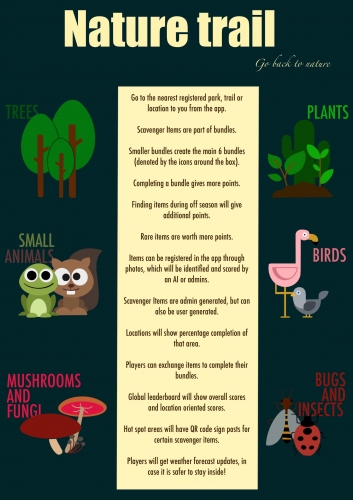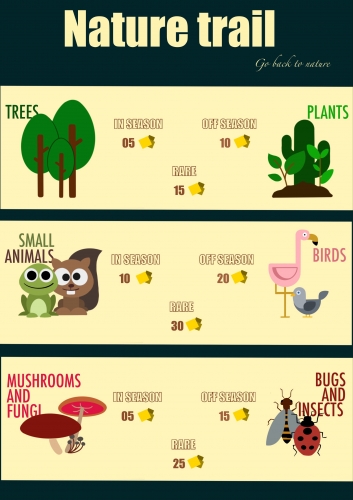This is the submission for APD Week 10 Play + Nature
PLAY AND NATURE (Nature Trail)
NOTE: This week's submission was done as a collaboration with Rahul Masakorala.
Rationale:
For the theme of Play and Nature, I decided to collaborate with Rahul Masakorala. Rahul has more knowledge about game, app, and 3D asset development, and I approached him as I wanted to work with him to see if I could learn something about one of those processes through an APD exercise.
The idea of the app/game that we came up with surrounded the concept of a scavenger hunt, but with the purpose to have the player reconnect with nature through play. Though this has been amplified due to COVID and lockdown, our busy lives create a situation where we do not have the time to learn about or relax in environments that is surrounded by nature.
Our goal was to take already existing parks, trails or reserve forest areas that are accessible to the public and use them as locations for scavenger hunts where players go to look for certain trees, plants, birds, animals, mushrooms or insects, learn about them and earn points while doing it.
Context:
Initially we wanted to do something with rainwater harvesting, as the week for Play and Nature had a lot of rain forecast. But as we brainstormed ideas, taking into consideration the lockdown, weather and equipment at our disposal, we took elements of all out failed ideas to come up with the idea and rules for Nature Trials.
We took inspiration from apps and games like ‘The Original Scavenger Hunt App’, ‘Let’s Roam’ and ‘Stardew valley’. While the first wo apps helped us come up with the functionality, look and design for the app, the game Stardew Valley was a great inspiration for the game elements such as bundles, point system and rules. We also took inspiration from the projects Matt talked about during the class.
We decided that every location would have admin(s) to curate the bundles that need to be discovered and be the person to register people’s discovery. While we decided to have global and local point systems, it isn’t to promote competition. It is more to promote play with the notion that there is more to discover and learn if you want to.
Method:
Given our skillset and time frame, we decided to do a mock-up of the app that would give an idea of how the game would function and what the app would look like.
Once we decided what the rules are going to be with respect to the goal of the app, we split up the workload as each of us had a different skillset and access to different software.
Rahul worked Adobe XD to make a mick up of the app, while I worked on the asset creation (for the bundles, points items, etc.), colour palette and images for the rules and point distribution page. I also collected a group of pictures for each bundle that Rahul could use for the items in the bundles of the app.
The decision to have a scoreboard was made to prompt players to go out and discover more. The points do not tell you how much better other players are, but to signify how much of the location is still left to discover. There is no reward for completion, as the goal is to help people learn more about nature in their immediate vicinity.
Simple concepts like getting more points to for finding items off season, or finding a rare item is there to incentivise the players. We also discussed how players can trade items if they find the same item multiple times. This will not only give information about the item to the player you are trading with, but they will also get more information about where to find the item exactly so that they can locate it more easily. We discussed how hot-spot locations can have QR code signposts for people to spot and gather information more easily. An example of that is there in the app demonstration.
We also decided to link the app to the weather forecast, so that the app can give weather warnings when it is not safe to scavenge outside.
Here is the link to the a video for the mock up of the app and how it works: https://www.youtube.com/watch?v=2ZUyQh6Tajw&ab_channel=RahulMasakorala
Response/Reflection:
We wanted to find a way to bring people closer to nature through play and a more approachable method. When it comes to how we developed the app/game, we used the theory of loose parts to come up with it. We took materials and concepts from the various discarded ideas we discussed earlier, to design, redesign, and tinker with to come up with a creative solution to incorporate play with nature.
While our process tapped into the theory of loose parts with respect to play, the app itself has a relatively more organised form of play (constructive play). Players learn about the attributes of different materials (in this case the items and bundles) and engage their curiosity by giving them more information about the items and bundles they discover.
While this isn’t a fully realised concept, it lays down a good framework for something that can be further developed into an idea that promotes play with the reconnection of oneself with nature.
“Teaching children about the natural world should be treated as one of the most important events in their lives.” – Thomas Berry
This can not only be used an educational tool for children (with supervision), but also work for adults who are looking to expand their knowledge about local flora and fauna in a more fun manner. After all, nature is the best playground.
About This Work
By Priyankar Ray
Email Priyankar Ray
Published On: 10/10/2021

